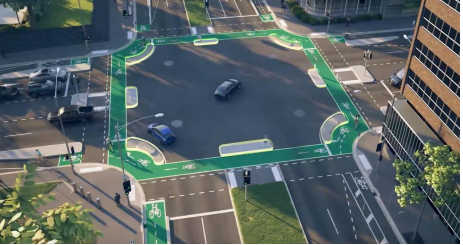Richmond council is on board with Coun. Kelly Greene’s suggestion to introduce safer cycling options in the city.
At Tuesday’s committee meeting, Greene asked council to consider implementing protected bike infrastructure, which could encourage more women and children to hop on a bike.
Council voted to send the suggestions back to staff to come up with solutions for safer cycling in Richmond, but Greene would have preferred if they had passed a motion immediately with the wording guaranteeing cycling was “protected.”
For Greene, protected bike lanes are a “no brainer.”
“It doesn’t say what kind of protection so it does let staff have input and control over what’s the most appropriate protection depending on where the location of the bike lane is,” said Greene, adding that she thinks referring back to staff on whether or not to protect bike lanes “is really a waste of time.”
Protected bike lanes are fully separated from the road, for example, by a barrier or built as a multi-use pathway.
“We could have voted on (the motion) and passed that so that we’re giving direction to staff and also indicating to the people of Richmond that we want to have modern transportation systems.”
The second part of Greene’s motion, which asked the city to consider using alternative bike infrastructure such as Dutch intersections, two-way lanes and Vision Zero principles, was also referred back to staff and supported by council, including Greene.
Council want staff to determine, for example, how protected lanes could be implemented, whether they could be painted different colours to stand out from the road or if lights could be synchronized for bike safety.
According to Greene, the protected lanes could take on a variety of forms in Richmond.
“There’s all different kinds of barriers that can be built between cars and bikes and pedestrians. So it would depend on what the alignment of the road is, how much room there is…There’s a lot of variables,” said Greene.
“I think it’s important not to be prescriptive, because depending on where you are in Richmond, it looks different. But there (would be) protection and I think that is fundamental.”
These protected lanes are also used at intersections — known as a Dutch-style intersection — leading to reduced crossing and turning conflict between cyclists, pedestrians and motorists, as cyclists have their own dedicated lanes for turning and crossing.
According to Greene’s motion, Dutch-style bike intersections and protected lanes could help women and children feel safer when cycling in Richmond.
“Protected bike lanes have shown to increase participation by women and children when compared to painted bike lanes,” reads the motion, which notes that women have different risk perception from men and are less likely to engage, either by themselves or with their children, in activities they perceive to be riskier.
City council pushed for more bike lanes as part of the 2020 budget process, approving funds for a new lane in Steveston, design work on five different bike plan projects and money to teach all grade 6 and 7 public school students about cycling.
Another option put forward in Greene’s motion is two-way bike lanes.
Greene also asked the city to consider Vision Zero principles for new bike lanes.
The term Vision Zero was introduced in the late-1990s in Sweden, according to Vision Zero Canada, when that country’s government pledged to eliminate death and serious injury from its roads.
Vision Zero places a shared responsibility for safety on both those who use the roads and the people who build the road systems, rather than just on road users.
The motion also notes that active transportation modes, such as cycling, must have a higher rate of adoption in order to meet the city’s carbon emission reduction target.
City council declared a climate emergency in March.



